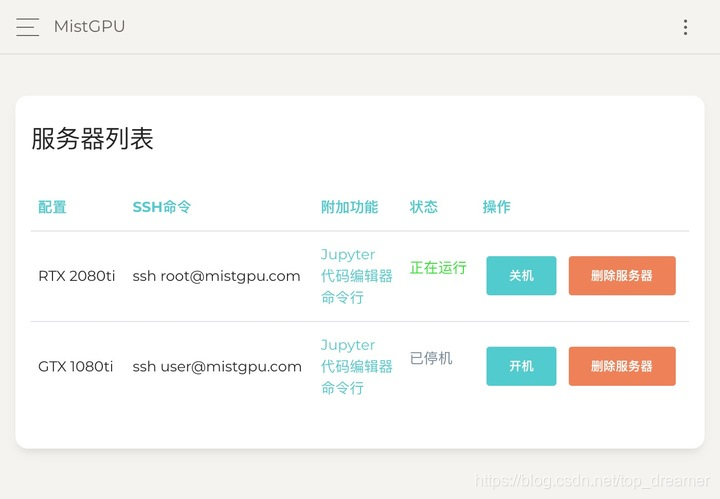推荐适合学生党做深度学习使用GPU的平台(薅羊毛)
本文共 203 字,大约阅读时间需要 1 分钟。
推荐适合学生党做深度学习使用GPU的平台(薅羊毛)
 如果小伙伴在实验室一块GPU都没有怎么做深度学习?那我推荐下MistGPU平台,使用特别方便,传输文件速度也特别快(存储文件1G以下免费),可以按需使用,使用量比较大的也可以联系客服按月使用。我目前在使用ing!注册就有免费试用,每邀请一个用户也有赠送使用8元金额,无上限!欢迎一起薅羊毛(链接如下)~
如果小伙伴在实验室一块GPU都没有怎么做深度学习?那我推荐下MistGPU平台,使用特别方便,传输文件速度也特别快(存储文件1G以下免费),可以按需使用,使用量比较大的也可以联系客服按月使用。我目前在使用ing!注册就有免费试用,每邀请一个用户也有赠送使用8元金额,无上限!欢迎一起薅羊毛(链接如下)~ 截图展示我目前正在使用的gtx1080ti的机器:

转载地址:http://vogs.baihongyu.com/
你可能感兴趣的文章
NMAP网络扫描工具的安装与使用
查看>>
NMF(非负矩阵分解)
查看>>
nmon_x86_64_centos7工具如何使用
查看>>
NN&DL4.1 Deep L-layer neural network简介
查看>>
NN&DL4.3 Getting your matrix dimensions right
查看>>
NN&DL4.7 Parameters vs Hyperparameters
查看>>
NN&DL4.8 What does this have to do with the brain?
查看>>
nnU-Net 终极指南
查看>>
No 'Access-Control-Allow-Origin' header is present on the requested resource.
查看>>
No 'Access-Control-Allow-Origin' header is present on the requested resource.
查看>>
NO 157 去掉禅道访问地址中的zentao
查看>>
no available service ‘default‘ found, please make sure registry config corre seata
查看>>
No compiler is provided in this environment. Perhaps you are running on a JRE rather than a JDK?
查看>>
no connection could be made because the target machine actively refused it.问题解决
查看>>
No Datastore Session bound to thread, and configuration does not allow creation of non-transactional
查看>>
No fallbackFactory instance of type class com.ruoyi---SpringCloud Alibaba_若依微服务框架改造---工作笔记005
查看>>
No Feign Client for loadBalancing defined. Did you forget to include spring-cloud-starter-loadbalanc
查看>>
No mapping found for HTTP request with URI [/...] in DispatcherServlet with name ...的解决方法
查看>>
No mapping found for HTTP request with URI [/logout.do] in DispatcherServlet with name 'springmvc'
查看>>
No module named 'crispy_forms'等使用pycharm开发
查看>>